MY WAKEFIELD FAMILY FROM NEW ENGLAND AND LAWRENCE COUNTY, OHIO
Researched and Written by Joyce Hayes Wagar
In all the research I have done, the Wakefield family has been the most documented. Much of the early information I have included come from the Wakefield Memorial, Comprising Historical, Genealogical and Biographical Register by Homer Wakefield, MD, 1897. I have written only about my direct ancestors in the section below. Peter Wakefield is the transitional ancestor who was born in New England and moved to Lawrence County, Ohio.
John Wakefield II, my immigrant ancestor, was born in England in 1614-1615. According to genealogist Homer Wakefield, John was a native of Gravesend, County of Kent, England, and came with Thomas Wakefield, probably his brother, on the ship America on 23 Jun 1635 landing in Virginia. Prior to 1647, John was on Chappaquiddick, Martha’s Vineyard, Massachusetts. He either owned or was a tenant on the property there but failed to fulfill the terms of residency and was forced to forfeit it to Nicholas Butler. Since John was a boatman or shipwright, he had probably been at sea instead of on the property. He moved to Boston by 1651 and bought a tract of land near the harbor.
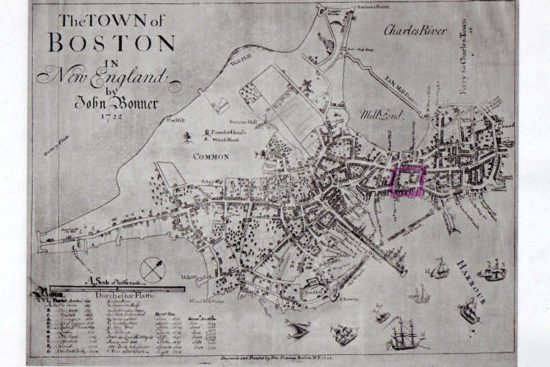
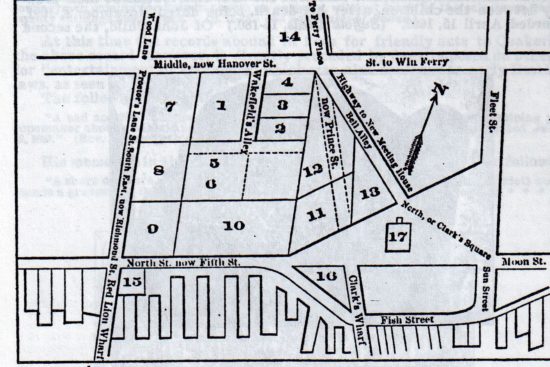
- Sites 1, 2, 3, 4, 5, and 6 comprise the estate of the immigrant John Wakefield.
- At a later date, sites 5 and 6 were the home of the parents of Paul Revere.
- Site 10 was the home of Increase Mather, a Puritan minister and president of Harvard College in 1692
- Site 14 was the home of Cotton Mather, son of Increase, who was the author of 400 books and pamphlets.
- Site 15 was the location of the historic Red Lion Inn
- Site 17 was the site of the Old North Meeting House
Wakefield was thrifty and fairly prosperous, but he had some serious setbacks. He was fined on 30 Mar 1659 for entertaining a Quaker. His house was struck by lightning on 9 Mar 1664 and badly damaged. He was killed while helping a rope maker on 18 Jun 1667 and was buried in the Granary Burying Ground. This cemetery was named for the 12,000-bushel grain storage building that was next door to the graveyard and is one of 16 historic sites on the very famous Freedom Trail Walk in Boston. Established in 1660, the Granary is notable as the resting place of Boston’s most famous sons and daughters. Others buried there are John Hancock, Paul Revere, Samuel Adams, Thomas Paine, and Mother Goose in Boston.
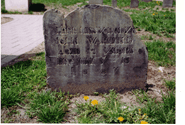 |
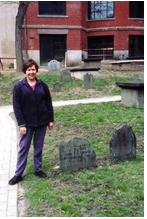 |
| John Wakefield’s Tombstone reads: Here Lies the Body of John Wakefield, aged 52 years, Ju 18, 1667 |
In 2002 I was able to visit the Granary Cemetery in Boston. |
Since John Wakefield II died intestate, his wife Ann was appointed administrator. The inventory of his estate included wearing apparel, household goods, half interest in an old boat, and half interest in a new boat, a house, and land. Ann later married John Child.
John Wakefield III, son of John and Ann, was born about 1640 probably in Edgartown, Massachusetts. He too was a shipwright and after his marriage to Deliverance, Tarne built a homestead on his father’s estate in Boston where he lived until his death in 1703. In 1691 he appeared on tax records. Like his father he is not on record as either a church member or a freeman of the colony; however, his children were recorded on the register of the First church, perhaps by his wife. Deliverance lived there until her death in 1716-7. Their son John IV was named administrator of their estate, which included such interesting items as six leather chairs, a brass lamp, 55 pounds of brass, and 22 rings.
John Wakefield IV, son of John and Deliverance Tarne, was born in Boston on 27 January 1668 at his father’s homestead, a share of which he inherited and resided on for some time with his wife Elizabeth Walker Wakefield. When she inherited property at the death of her father, they moved. John IV and Elizabeth were married by Cotton Mather on 23 November 1693. John was a shipwright, died on 31 January 1735, and was interred in the King’s Chapel burying ground, in Boston. His wife, grief-stricken when he died, was described as deranged and incapable of managing her own affairs so her son Samuel was appointed her guardian. She died on 1 August 1738.
Joseph Wakefield, son of John and Elizabeth Walker Wakefield, was born in Boston on 9 June 1701 and baptized on 15 June 1701 in the Old North Church. Joseph was a periwig-maker and was also engaged in the jewelry business, as a silversmith. He married the widow Copia Bridge Love on December 7, 1726, but she died soon after the birth of their only child Thomas. Joseph never remarried. Though he gave his son to someone else to raise, he left Thomas everything in his will “All of the remainder of my estate, both real and personal, whatever and wheresoever the same is, or maybe found, I give, devise and bequeath the same to my dear and well-beloved child, Thomas Wakefield, to beholden by him, his heirs, and assigns forever.” (The Suffolk Probate Records Book 31, p86)
Thomas Wakefield was born in Boston on Back (now Salem) Street on 5 August 1727 to Joseph and Copiah Bridge Wakefield. When his mother died soon after his birth, his father took him to the home of Dr. And Mrs. Abraham Gould who raised him until he was old enough to learn the carpentry trade. He married Dorcas Pratt, daughter of Timothy and Tabitha Pratt who lived “side the pond” which was Lake Quannaopowitt in Wakefield, Massachusetts. (Later in 1873 a relative Cyrus Wakefield went to Wakefield, Mass to manage Wakefield Rattan Company which is still a thriving business) Thomas and his family moved to Amherst, NJ in 1760. He took part in the renewal of the charter and as a selectman certified the pledge of the citizens of Amherst, in 1776, to support the cause of the colonies. He was regarded as an honest, upright, highly respected citizen who held the position of town clerk and selectman for eighteen years. After his death in September 1791, his wife moved to Redding, Massachusetts where she died on 25 November 1802.
THE WAKEFIELD FAMILY
LAWRENCE COUNTY, OHIO
PETER AND KEZIAH BURNS WAKEFIELD
My Great, great, great, great grandparents
Peter Wakefield (descendant of Thomas, Joseph, John, John, John) and one of seven sons, was born in Amherst, New Hampshire on 7 Aug 1764. About 1 Sep. 1781, he enlisted as a private in Capt. John Mills’s company, Colonel Runnel’s New Hampshire regiment and served about three and half months. He was one of the eleven soldiers that marched to Charlestown on 23 Sep. 1781.
Late in the summer of 1781 eleven men were called to serve three months. They marched on September 23d of that year. In the selectmen’s account, they are mentioned as “11 soldiers at Charlestown, 1781,” and were probably raised in the apprehension of trouble on the Western and northern frontiers of the State. Their names were Peter Abbot, Daniel Averill, Elijah Averill, George Christopher, Paul Crosby, John Fields, Edward Hartshorn, Joshua Heywood, Samuel Phelps, Peter Wakefield, and Daniel Weston, and they served in a company commanded by Captain John Mills (Secomb’s History of Amherst pg. 397; also Rev. Records, War Dept., Washington D.C.)
On 10 Aug. 1782 at Boston, MASS., he enlisted on board the frigate DEAN, afterward, The Hague, commanded successively by Capt. Nixon and Capt. John Manley served about nine months, during which time he was engaged in a number of skirmishes. (Record, Pension, Dept. Washington D.C.). After peace was declared, Peter refused to pay taxes for the support of the clergyman and was sent to prison.
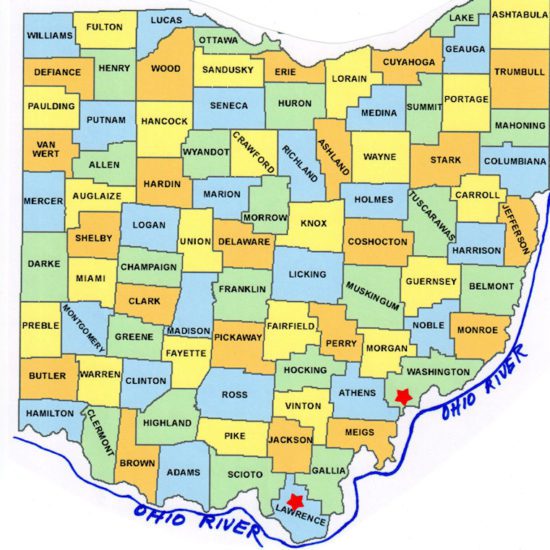
He declared that he had fought for freedom and was bound to enjoy it and so sought it by removal to Ohio in 1806 with his wife Keziah Burns originally from NY and their young family. Peter and Keziah had married on 3 March 1791. In Ohio, they went first to Washington County and then to Lawrence County.

The first settlement in the Windsor township of Lawrence County was made by Peter Wakefield near what was later called Scott Town. He was a cooper (a maker of barrels and casks) and a farmer. A prominent pioneer settler, he served as justice of the peace for forty years in Windsor Township which he named for Windsor, CT
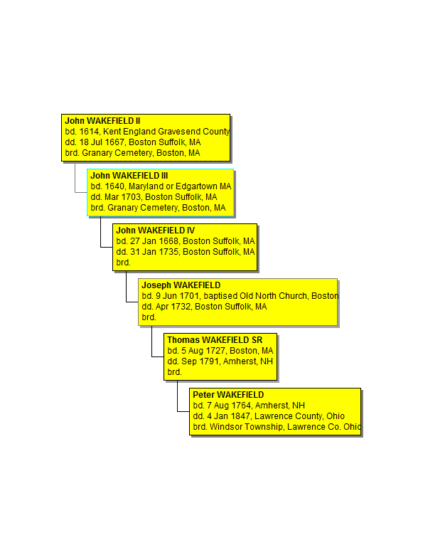
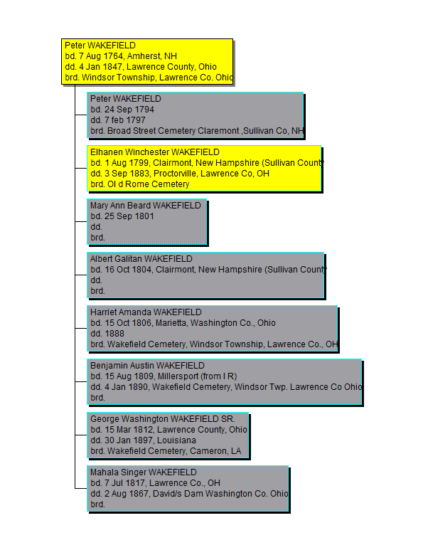
Peter and Kaziah Wakefield’s children
Peter Wakefield at the age of 68 applied on 28 Aug 1832 for a pension. He was a pensioner for a number of years before his death. Honorable Josephus Wakefield, of Freemont, Wisconsin, writes that Peter was a large, strong, active man, weighing 230 pounds. Peter Wakefield adhered to the Universalist faith in early life but in his later years identified himself with the Methodist Church. He died in Lawrence County, Ohio, Windsor Township January 1847.
(Historical, Genealogical and Biographical Register by Homer Wakefield, MD. 1897) Benjamin A. Wakefield son of Peter Wakefield was praised in this article in the Ironton Register, on 28 August 1890.
This (Bartramville) is one of the pleasant farming communities among the hills of this country. It was here in this community that old father B. A. Wakefield reared his large family and sent them out upon life’s mission. Two are now in Missouri, one in Kansas, one in Marietta (Ohio), and five are here in this community. Of the five in this community, two are wives of well-to-do farmers, Messrs. C. Forgey (Mary or Nancy) and H. Forgey (Mahala), and B. F. Wakefield have the old homestead farm: the other two of this community, Miss Cora and J. D. Wakefield are in the old homestead with their mother (Providence James Wakefield).
Miss Cora is one of our efficient teachers and J. D. is studying the medical profession. The two in Missouri are successful farmers, the one in Kansas is a mechanic, doing well, and the one in Marietta is the wife of a professional man. To rear a large family like this and see them taking hold of the duties of life and making an honorable record for themselves, is, to your correspondent’s mind, the greatest achievement allowed to man. Who can conceive of the possibilities to be reached by the members of such a family? Let them choose the God of their father and He will lead them.
Old father Wakefield was one of the members who secured the erection of the old Windsor Chapel (1856) here on the hill. While Alison was building the Old Ridge furnace and the democratic party was bending its energies to put James Buchanan into the White House, Father Wakefield with others was striving to secure a house in which to worship God. “Mark the perfect man, and behold the upright, for that man, is peace.”
In the Ironton Register on October 18, 1888, a reporter wrote of Peter’s son Benjamin Austin and grandson Benjamin Franklin (Frank) who lived on the homestead. B. A. Wakefield, one of Lawrence County’s oldest and best citizens was born in Millersport in 1809 and is therefore in the 79th year. Mr. W. is quite supple and delights in talking about olden times. Mr. W. will caster his vote for HARRISON…
Mr. W’s father Peter Wakefield had a mill not far from the place he now lives. Frank (his son) works the farm; has 35 acres, No. 1 corn, 180 bushels wheat, 80 bushels oats; will sow 40 acres of wheat; has 3 acres heavy cane, 30 head cattle, 25 hogs, 75 bushels potatoes, an only half crop of apples; have a fine lot of turkeys and chickens and 22 Penguin ducks. Frank says they have the right name, for they are always seeking something.
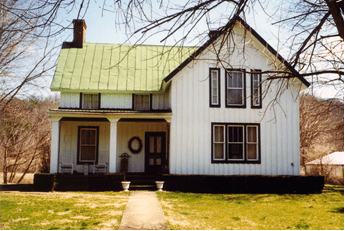
I visited the farm now owned by Frank and Susie Love. The house the Loves live in was built about 1846 by Benjamin Franklin Wakefield on the original Peter Wakefield land. The Wakefield Cemetery is across the road on the hill.
Elhanan Winchester Wakefield, my great, great, great grandfather, was born at Claimant, NH on 1 Aug. 1799; and when he was only about eight years of age, he accompanied his parents Peter and Kaziah and other New England emigrants going out from their homes to seek their fortune in the ‘west’, which then included Ohio. In 1807 his family became one of the first settlers of what, some ten years later, was to become Lawrence County, Ohio.
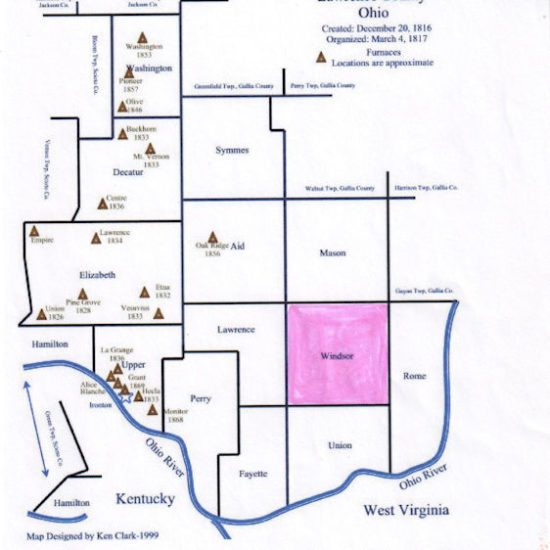
Being one of the New England emigrants to Lawrence county accounts for why his family early became identified with the anti-slavery movement. However, they found enthusiastic support from their neighbors who had come from Virginia and were, for the most part, also opposed to slavery. During his youth, Elhanan found conditions in Union Township about as primitive, perhaps, as we today can imagine.
But like their neighbors, the Wakefields set about carving a home out of the wilderness and the establishment of those institutions so needful to a civilized community. On 3 September 1827, Elhanan married Candace Gillett of Rome Township. Candace, a member of the pioneer family, the Gilletts of Rome Beauty apple fame, was born in Ulysses County, NY 23 May 1807. Her parents were Joel Gillett and Chloe Griswold Gillett.
The following was written by Jean Griesen and posted on the Lawrence Register. (www.lawrencecountyohio.com)
Joel Gillet moved several times before settling in Lawrence County, Ohio. These moves were made with Joel’s three brothers, Zebulon (older brother), William, and John, and his older sister, Comfort (Gillet) Pritchard, and their families. The family left Connecticut and moved to western New York in about 1801. They lived in the town of Hector in Seneca County, New York. In 1815, the family wished to move on to Ohio, so they hired wagons to haul their families and household goods and set out on what was then considered a long journey across the Allegheny Mountains. When they reached the Allegheny River, they put their goods on a pine lumber raft. They erected a temporary shanty on the raft in which to live during the trip. They reached Marietta, Ohio quite comfortably. Joel took a lease of land and stayed until the lease ran out.
In the fall of 1816, the Gillets moved farther down the river in a small flatboat they had built. They moved to the area that was to become Rome Township in Lawrence County, Ohio. (Lawrence County wasn’t formed until 1817.) Joel’s youngest brother, John, continued west and was lost track of. Joel bought a farm of one hundred acres in southern Rome Township on the Ohio River from Nahum Ward in June of 1816. Joel paid $1100 for the property. He built a two-story hewed log house that stood on the riverbank. The front wall and roof were covered with a yellow-flowered creeping vine. This property was the only grassland in the township at the time.
At this time, there were no roads in Lawrence County. There were simply trails, and the whole county was covered with timber and much of it was heavily timbered. The ground underneath the timber was a perfect jungle of underbrush, but cattle eventually destroyed most of the brush, so that one could ride on horseback pretty comfortably through the woods.
The settlers of this time had to literally dig and hew their farms out of the solid forest. There were no prairies. The timber was utterly valueless and had to be chopped down, cut, piled, and burned up. It required a vast amount of labor to grub the underbrush that covered the ground before it could be plowed and planted. They had roads and bridges to build, houses and barns to construct, fields to clear, and orchards to plant; but few of them brought any money, and none of them had much. Their strong arms and determined purpose were their only capital.
The wool was carded, spun, and woven in the house for winter wear and blankets. The hides from beef, sheep, and veal were taken to the tanner, who gave half of the leather to the farmer. The farmer then hired a shoemaker to come to the house each fall to make shoes for the family for winter use. In the case of the Gillet family, Joel was a shoemaker, so he probably made shoes for the family, and possibly for neighbors too. In summer, the young people and children all went barefoot. No one wore ornaments, jewelry, or fine clothing. No one had luxuries and few had the common necessities of life.
It was a desperate struggle these pioneers had against nature, for existence, and for civilization. Tea and coffee were luxuries that few could afford in those days. The only sugar used then was made from the sugar maple tree. Every mother made her own bonnets and clothing, as well as clothing for the whole family.
In readying his new home in Lawrence County, Joel decided to have an apple orchard on his property. He brought about 200 grafted fruit trees from the Putnam Nursery near Marietta with him during the move. In early May of 1817, he was ready to set out the orchard. There was one seedling that was smaller and different from the others. He gave that one to his 14-year-old son, Alanson, and told him, “Here’s a Democrat. You may have this one.” Young Alanson planted his seedling down by the river. On that same day, a young man named Thomas Gardner had come to see Joel’s oldest daughter, Chloe. He helped with setting out Joel’s orchard.
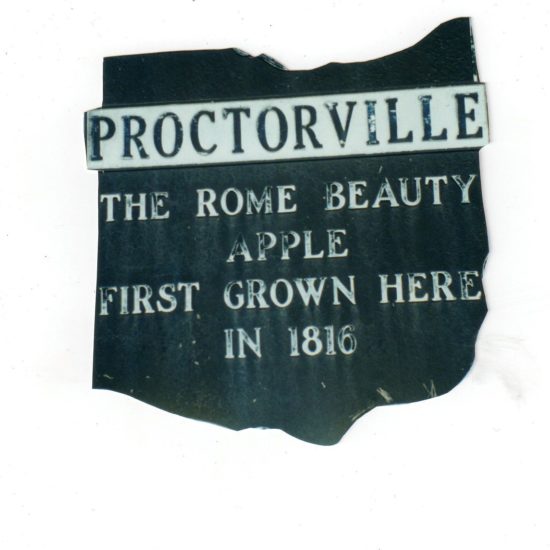
In about 1830, a neighbor, George Walton, named the apple the “Rome Beauty” apple in honor of Rome Township and the fine appearance of the fruit.
A few years later, Alanson’s tree was producing such nice fruit that people began to take notice of “Gillette’s seedling.” The fruit was red and juicy and tasted sweet. Horatio Nelson “H.N.” Gillett, a cousin of Alanson’s and a son of Zebulon’s, was the first person to take a graft of Alanson’s apple tree. Other farmers also began to take grafts of the tree. H.N. Gillett started a nursery and began to promote this new apple. In about 1830, a neighbor, George Walton, named the apple the “Rome Beauty” apple in honor of Rome Township and the fine appearance of the fruit. After this, most of the orchards in southern Ohio contained mostly the Rome Beauty apple. The original tree lived 40 years on a sandy knoll in a corner of a field near the Ohio River. It stood until the riverbank caved in during a flood in 1856.
Joel had to borrow $100 from his brother-in-law, Nathaniel Pritchard, to finish paying on his land. Joel had only paid the interest. Joel was to pay off the $100 by furnishing a man from Zanesville with a load of stones and hoop poles. The man took the goods but never paid for them.
Joel’s wife, Clara, began to get very sick. She called her children to her and told them to be good, to love God, and to meet her in heaven. She died in early 1820 in Lawrence County, Ohio. She was buried in Rome Township. Soon after, Joel married a widow, Azuba (Pingrey) Risley.
Elhanan and Candice settled on a farm in Union Township, Lawrence County, Ohio, and became the parents of a large family. In spite of the handicaps of a frontier community with almost no schools, practically every member of the family secured a fine education for their time. Particularly was this true in religious reading and study? Three of their sons became ministers of the gospel, one, in particular, being a leading preacher in the Methodist Episcopal Church. Three of the daughters were teachers and two of the sons also taught for a period. In addition, four of the five sons fought in the Civil War. The Ironton Register 14 February 1878 reported that E. W. Wakefield sold his Bowling Green, OH farm to Mr. (Peter) Dillon for $4,500 and bought John Berry’s house and lot, corner Elizabeth Street and Broad alley, Grant town.
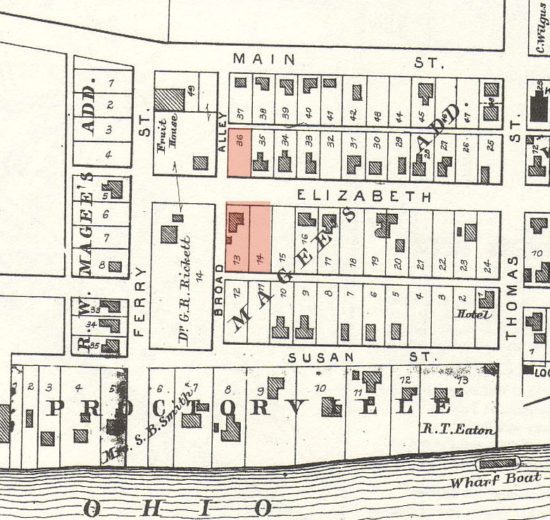
The area outlined in red identifies his property
Elhanan Winchester Wakefield, Sr. died September 3, 1883. His will which was probated in 1885 granted $25 to Albert Joel, $50 each to Dianna Holroyd, and her sons Oliver Cromwell and William W. It granted a lot of lands no 36 in Proctorville, OH to John W .and $100 each to sons Elhanan Jr. and Peter. He gave Lot No 14 Proctorville to be divided equally between grandson William Albert Reed, son of daughter Miranda, and to Willard W and Alice, heirs of son Columbus. To his daughter Miranda he gave lot No 13 where he lived in Proctorville. He also gave her notes, bonds, accounts, household, and all other property when his wife Candace died. Some of the Wakefields continued to live in Lawrence County and farm the land.
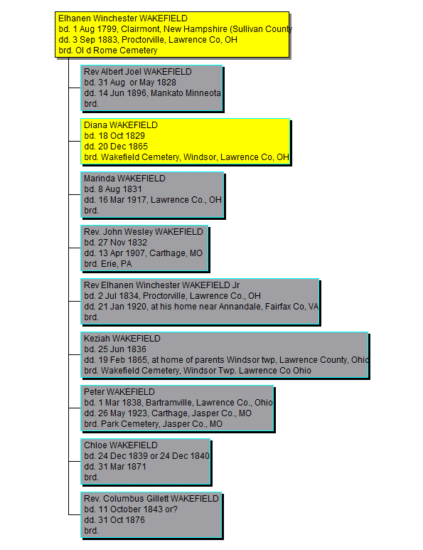
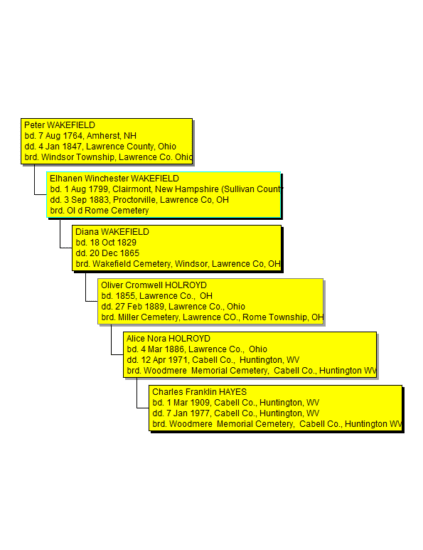
Albert Joel Homer Wakefield wrote that Albert Joel Wakefield attended Burlington Academy in Burlington, Ohio, and taught several terms of school, married Hester Skelton in 1851. He was vice president of the Teachers’ Association in Lawrence County. (Ironton Record 11 Nov 1858). He served as a private in the Civil War in the 17 Independent Battery, Ohio Light Artillery.
He was engaged at Fort Morgan, Spanish, Fort, and the battle of Blakely and was discharged on August 16, 1865. In 1866 he moved his family to Kasota Township near Lake Washington Minnesota and in 1871 bought a farm. In his later years, he was a Methodist minister and traveling salesman. In 1874 he was appointed postmaster of Lake Washington. He was nominated representative to the state legislature in 1875 but he was defeated, as the district has a large Democratic majority. He and his wife Hester had 9 children. The Ironton Register noted on 7 November 1895 that Mrs. J. K. Lankard, who was Miss Susie Wakefield, daughter of A. J. Wakefield had died at Redwood Falls, Minnesota at the age of 36 of consumption leaving four children.
Dianna, my great, great-grandmother, married William Holroyd. Their story is in the chapter separately published by the Holroyd family. Sadly just six months after William Holroyd got home from the Civil War, his wife Dianna died on 20 December 1865 at the age of 36. Surviving her were her husband and three children: Florence about 12, Oliver Cromwell, my great grandfather, about 10, and William W. about 6. The Ironton Register 18 January 1866 described her as a teacher and a devoted Christian.
At her residence in Lawrence County, OH Dec 20, 1865, Mrs. D. W. wife of Wm. Holroyd and daughter of E. W. Wakefield, of this county, died at 36 years. From the early age of 12, she lived as a professed and consistent Christian. Although afflicted for several years, she never bore it with Christian fortitude. While impaired in physical strength her mind remained clear and rational with a bright hope of immortal glory. She feared not death but fully realized the Angel of the Covenant was faithful to his promise and stood prepared to walk with her through death’s dark vale.
When asked how she felt while struggling with the monster’s death, she sweetly smiled and said, “Jesus was…. she was nearing the Haven of eternal bliss. For many weeks we watch over her with anxious care, trusting the one so dearly loved might yet be spared but we out to eat on earth a spirit rule for Heaven. How vain the day had come the day that closed all earthly friendships and finished every east of love. Day of eternal gain for worldly loss. With a firm confidence in Him who careth for the orphan, she committed her charge to his trust, then calmly and composedly fell asleep in Jesus. Truly she lived the life of the righteous. A companion, three children, and many friends mourn.
Servant of God, well done
Thy earthly ties are riven,
Thy work is wrought, the crown is won,
And thou are saved in Heaven.
Yes, thou art freed from cumbering clay,
No more of earth’s vain joys to know,
But dwell in Christ in realms of day,
To triumph o’er this world of woe.
We could not wish thee back to stay,
But we will meet in that great day,
Where pleasure is pure without alloy,
Thy precepts pure will get us through
This world of sorrow and sin
And will our wearied souls renew,
Till we the crown of glory win.
By C. W. (This may have been her sister Chloe Wakefield.)
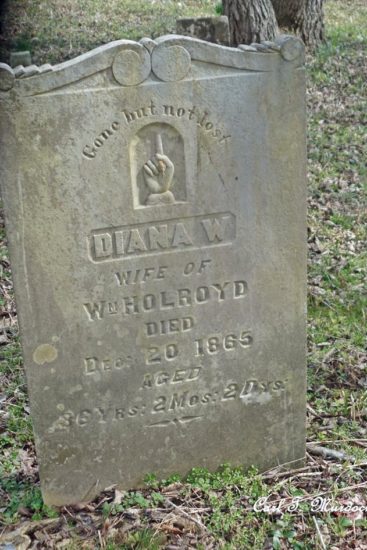
The Wakefield sisters showed affection and admiration for each other as expressed in this poem about Dianna and also in the poem written by Marinda at the death of Keziah. Diana was buried in the Wakefield Cemetery, which still exists across the road from the Love Farm which was originally the Wakefield home in Lawrence County, Windsor Township, OH. Dianna’s grandfather Peter Wakefield is also buried in this cemetery.
Marinda received the Mistress of English Literature at the Wesleyan Female College, Delaware, Ohio, and then taught in Quaker Bottom, Lawrence County, Ohio. She married at age 43 to William A. Reed, who died of consumption four years later One of their two sons died in infancy. In 1889 Marinda applied for a pension stating her husband had been hospitalized in September 1864 for chronic diarrhea and fever while in the military service.
On 5 November 1864, he was injured in a railroad accident while on his way home to vote in the Presidential election of that year. She claimed that those injuries resulted in consumption from which the soldier died. Her request was denied by President Grover Cleveland. (Compilation of the Messages and Papers of the Presidents on www.accessgenealogy.com) One of her students, the father of Dr. R C Hall remembered her in her later years as “a very religious lady and punctual in her attendance at church and various Christian gatherings.” She lived on Elizabeth Street in Proctorville for many years.
Only two of her siblings outlived her: Peter who resided in Missouri and Elhanan W, Jr. who lived in Fairfax County, VA. Elhanan Jr. with his wife visited her in 1912 and again in 1915 according to the Fairfax paper with the intent of moving there; however, he returned to Virginia where he died a few years later.
John Wesley was a recorder of Lawrence County in 1856; and when his term expired, he entered the Ohio Conference where he continued for many years. He married first Mary Riggs Valetter in 1859 and in 1890 he married Anna Welch. An article in the Ironton Register, 17 March 1887 told of his plan
To organize an itinerant church and for this purpose, has bought a large tent or pavilion which will hold 3000 people. In connection with it will be a fine choir of four voices. There will be several preachers connected with the organization and the tent will be moved about over the country wherever the field for usefulness opens in the north in the summer and in the south in the winter. The idea of the movement is to bring religious privileges and the gospel to people who do not otherwise go to church. Mr. Wakefield will star in the work on the 5th of May (1887) spending two Sundays at Columbus. He is trying to get Talmage (possibly Rev Thomas Dewitt Talmage a prominent Presbyterian minister at the time) to dedicate the pavilion.
The Iron Register described him as “a man of energy, a strong preacher, and a good man who will make it win.” He was a minister with the Western Conference of Pennsylvania Churches of Methodist Episcopal from 1890 until his retirement in 1900. He died in Carthage, Missouri where possibly he was visiting his brother Peter who lived there, and he was buried in Erie Cemetery, Erie, Pennsylvania. His obituary appeared in the Erie (PA) Daily Times, Monday 15 April 1907.
Elhanan Winchester Jr. known as the Rev. Elhanan Wakefield, early in his career, espoused the anti-slavery cause. When the call came for volunteers to help John Brown and others bring Kansas into the Union as a free state, Elhanan Wakefield was one of those who grasped his musket and hastened to the defense of freedom, according to the date we have on his subsequent career, he settled at Annandale, Fairfax County, Virginia, after the Civil War. Later he returned to Proctorville, Ohio, when his sister, Mrs. Reed, became ill. He will be remembered by many people in the tri-state region. To his last days on earth, he carried one arm in a sling as a result of the sacrifices he made in his youth for the cause of liberty on the plains of Kansas early in his career espoused the anti-slavery cause He served in the Civil War
First Sgt. Wakefield and the Little White Church
(This article appeared in Mosby Vignette, Volume VII, published by Don Hakenson & Gregg Dudding, in February 2003)
Elhanan Winchester Wakefield, Jr. was born in Lawrence, Ohio on July 2, 1824. In his early manhood, at the age of 15, he went west to strike his fortune as one of the original forty-niners! Instead, he only encountered fighting Indians in the Black Hills of South Dakota before ending up fruitlessly searching for gold in San Francisco, California. On February 9, 1863, while living in San Francisco, Elhanan W. Wakefield enlisted as a private in Company F, the California Battalion. He was 5 feet, 9 ¼ inches tall, light complexion, gray eyes, and light hair, and listed his occupation as a carpenter before the war.
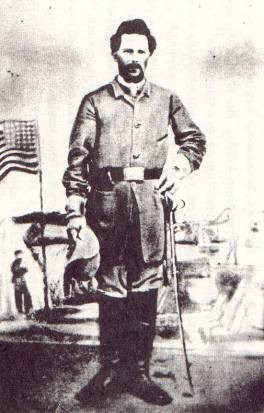
On February 9, 1863, while living in San Francisco, Elhanan W. Wakefield enlisted as a private in Company F, the California Battalion. He was 5 feet, 9 ¼ inches tall, light complexion, gray eyes, and light hair, and listed his occupation as a carpenter before the war. The photo at the left is First Sergeant Elhanan W. Wakefield Jr. in his Union uniform.
The California Hundred and Battalion were the only organized group of Californians to fight in the East during the Civil War in Northern Virginia. This unit consisted of 500 men who volunteered their enlistment bounty to pay their passage across Panama before finally arriving in Massachusetts, where they would become a cadre of the Second Massachusetts Cavalry.
In an interview with Ralph S. Payne of the Baltimore News on January 23, 1897, Colonel John S. Mosby, former Confederate Partisan leader during the War Between the States said, “The most formidable body of Union cavalry I encountered was the California Battalion, 500 strong, in command of Colonel Charles Lowell, a kinsman of the poet and diplomat James Russell Lowell. It was perhaps the best-equipped and gamest company of horsemen in the Federal service. They excelled both in stature and horsemanship, their personnel consisting of miners and men from the plains, who were accustomed to hardship and adventure.”
In March 1863, Private Wakefield was promoted to Sergeant effective April 1, 1863, and on September 14, 1863, Sergeant Wakefield was promoted to Wagon Master by order of Col. Lowell himself.
It was from mid-1863 to July 1864, that the California Hundred with Sergeant Wakefield fought in countless guerilla fights in Northern Virginia against the guerilla chieftain John S. Mosby. During the battle of Gettysburg Sergeant Wakefield was responsible for the ammunition train conveying the powder to the battlefield. From September to December 1863 Sergeant Wakefield’s unit was on detached service and would set up its camp in Vienna, Virginia. It was probably during the early 1864 period that Sergeant Wakefield with a small contingent would be ordered to torch the Little White Church in Annandale, VA.
In July 1864, the regiment became a part of Sheridan’s Army of the Shenandoah and on October 5, 1864, Sergeant Wakefield was transferred to Company C. and promoted to First Sergeant. His tenure as First Sergeant would be short-lived because on October 8, 1864, near Tom’s Brook Colonel Lowell would have a horse shot out from under him and First Sergeant Wakefield would receive a bullet wound in the left lung.
Wakefield’s horse, its saddle creased by a rebel bullet, was found later that day and Colonel Lowell would mount him throughout the next day’s fighting. Even though First Sergeant Wakefield could no longer provide service for the Union Army, his horse still could. Sgt. Wakefield was so near death that he was taken as a corpse on the battlefield and barely escaped being buried alive when the men who were filling his grave noticed signs of life. Elhanan had plenty of life still in him! In the official muster rolls dated March 17, 1865, he was admitted to Rulison General Hospital at Annapolis, Maryland on January 4, 1865, due to a gunshot wound received at Tumbling Run (Tom’s Brook) on October 8, 1864.
The final determination was that First Sergeant Wakefield was not a fit subject for the Veterans Reserve Corps and that he was officially totally disabled. The soldier also stated that his desired address was Alexandria, Virginia. According to the Southern Claims records Sergeant Wakefield knew Lucinda Tennison, the mother of Rebecca since the spring of 1864, and lived with the Tennison family in March 1865 while recovering from his wounds.
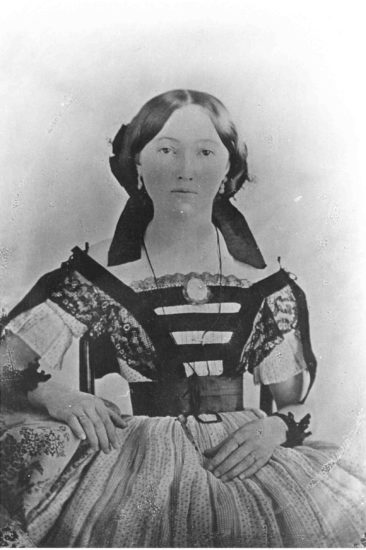
On September 5, 1865, shortly after the cessation of the conflict, Elhanan Wakefield wed Rebecca M. Tennison in Fairfax County, and two years later bought the farmhouse in an auction in Fairfax and made it their own home for their eventual ten children described in his obituary as “all useful and honorable.”
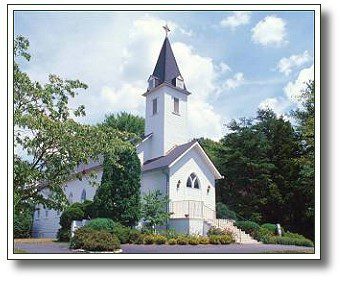
According to the history of the Annandale Church titled “A History of Annandale United Methodist Church” the same Elhanan Wakefield who had been ordered to torch the church assisted in rebuilding. His occupation as a carpenter paid dividends in repairing the Little White Church.
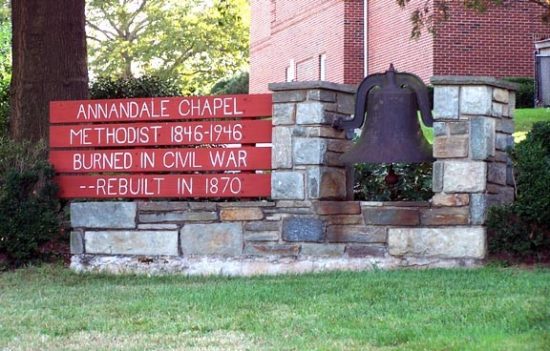
Elhanan was especially interested in religious work and would become the first Sunday School Superintendent of the Annandale Church. Although he served as a Local Deacon of the denomination, he never became a regular itinerant preacher of the Little White Church, but would later withdraw and become a minister of the Methodist owned by Fairfax County.
Reverend Wakefield was a proud man and never filed a pension with the U.S. government, but suffered continually from the wounds he received from the war. According to the Fairfax Herald dated October 2, 1903, Reverend Wakefield had an X-ray conducted that revealed that he still had two balls in his shoulder, which was the source of his misery that stayed with him his entire life. In addition to preaching, he gave presentations about his Civil War experiences.
In 1907 Rebecca died and in 1913 Wakefield married young Ada (Ida) Chaines. It is thought by his granddaughter Grace that this photo below is of Elhanan and Ada and his family between 1913 and 1920.
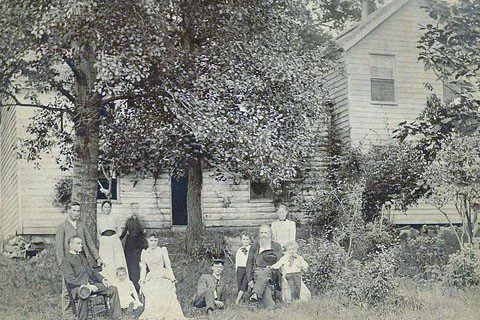
In January 1920, he died at his home in Idlywood, in Fairfax County at age 85 or 86 years old, and was buried alongside his first wife in the churchyard at Annandale Chapel. On the tombstone under his name is the inscription “Second Mass. Cavalry,” with the added lines “And now he has gone to be a soldier in the army of the lord.”
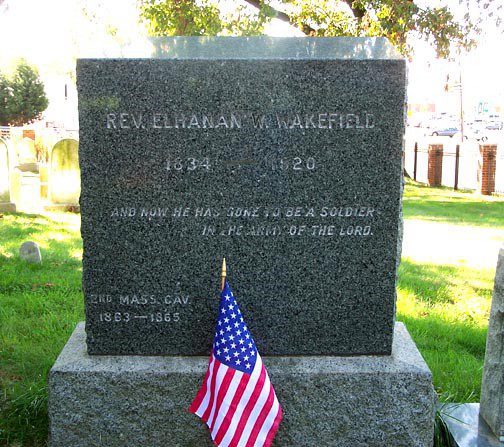
George H. Williams, a Confederate Veteran of the Eighth Virginia Infantry, and a member of the Annandale Chapel wrote an obituary for First Sergeant Wakefield and stated “I have known of his untiring labor not only in the church but among the people who needed his help for indeed the night was never so dark or the roads too rough for Bro. E. W. Wakefield to go to those who were sick or in trouble..” In his 85th year he heard the command “Come up higher,” and he obeyed.”
“Servant of God well done
The battle is fought, the victory won,
And thou art crowned at last.”
Keziah attended Ironton High School and like several of her family taught in public schools for several years in Lawrence County, Ohio. She died at 28 years at the home of her father The following stanzas in memory of the late Miss Kazia Wakefield, well known to many in this county, appeared in the Ironton Register on 20 July 1865. It was probably written by her sister Marinda. It was signed MW.
Though her earthly mission is done,
Although her from the grave hath won
To its oblivion and gloom,
Barred from us in the drear tomb,
To lie for aye.
Yet tell me not that she is dead,
Her spirit released, hath but fled
to realms of day.
When our family band doth meet
Sisters, brothers, parents to greet,
Around the domestic hearth,
Sorrow now shade our wanted mirth,
Since one so dear
To us and home, returneth never,
But to each she seemeth ever
Still fondly dear.
Her voice, her smile, many now miss
Evermore; but her cheerfulness
Mirrored on memory ,doth endure
Her influence, hallowed and pure,
Is still living.
Like a flower reared by her care,
Opening in beauty to the air,
Fragrance giving,
Nor more at church, she fills her seat,
Where with worshippers she used to be;
The hour for Sabbath School does pass,
She teacheth not as ever her class,
But ah, tis well.
She now rests and her works we see,
Do live and in Eternity
For good will to all.
Though her earthly mission is done,
Though her form the grave hath won,
An early victim to its gloom,
Beyond the victims of the tomb,
She live for aye.
With Christ elect, she doth enjoy
Eternal bliss without alloy
Peter joined the Ironton Ohio Artillery Company and he enlisted in the 7th WV Cavalry of the Union Army His unit was W. R. William’s Company. He mustered out on 18 November 1861 as a corporal. Sometime soon after his marriage to Mary Jane Skelton on 1 January 1863 they moved to Carthage, Missouri. After Mary Jane’s death, he married Anna Wolf of Indiana. They farmed and raised their four children in Carthage, MO. Peter lived 85 years and Anna lived 73 years.
PETER WAKEFIELD, farmer and stock raiser, was born in Lawrence County, Ohio, on March 1, 1838, and raised there, where he was educated. His father, Winchester, is still living on his farm in Ohio. The subject of this sketch enlisted from Ohio in the Ironton Artillery, and subsequently in the Seventh Virginia Calvary. Mr. Wakefield has been twice married; first on January 1, 1868, to Mary Skelton, who was born in June 1844, in Cincinnati, Ohio, and has been deceased since May 1872.
He was again married to Anna Wolf on February 26, 1879, who was born in Park County, Indiana February 27, 1858. They have one child, Nellie by name. Mr. Wakefield came to St. Charles County, Missouri, and to Pettis in 1865. In 1869 he became a citizen of Jasper County. He owns a finely located farm of eighty acres, about three miles northwest of Carthage in section 30, township 29, and range 31 of Marion township. Both Mr. and Mrs. Wakefield are earnest workers in the Methodist Episcopal Church and respected members of society. Mr. Wakefield raises good crops, has one of the finest orchards in this section, and is a genial obliging gentleman. (Missouri Archives Jasper County)
Chloe attended Normal University, Lebanon, Ohio, and taught in public schools in Lawrence County, Ohio. Her journey from Ohio is not clear, but she probably went to Minnesota with her brother Albert Joel and his family about 1869 for she is with them in the 1870 census. According to Homer Wakefield in “Wakefield Memorial,” on 13 September 1870 in Corrine, Utah, she married George Washington Wakefield, Jr., her double cousin, the son of George Washington and Emily Gillett Wakefield. Chloe and George’s fathers were brothers and their mothers were sisters. Chloe died very soon after their marriage on 31 March 1871 in Minnesota.
Columbus Gillett attended Ohio University at Athens, taught school in Lawrence County, and then became manager of Aetna Iron Furnace. His first wife is not known but they had two children, Willard Warwick and Ora Alice. According to Homer Wakefield in his 1899 genealogy, Willard lived in Missouri and Ora Alice in Minnesota.
I speculate that Columbus’s wife died and his son lived with Columbus’s brother Peter and his daughter lived with Columbus’s brother Albert Joel. He served three years in the Civil War in Company G, 4th Regiment, Ohio Cavalry. He was licensed to preach in the Methodist Episcopal Church. In 1870 he married Sarah Doty and they had one daughter who died in infancy of cholera. Columbus died in Lawrence County at age 33.
A newspaper article that appeared in the Huntington WV., The Herald-Advertiser 19 June 1938 by Dr. R. C. Hall focuses on three pioneer families in Lawrence County. About the Wakefield family he wrote:
“There have been perhaps few pioneers whose descendants became as widely known as E. W. (Elhanan Winchester) WAKEFIELD. By widely known we mean that they scattered far and wide and became leading citizens in many and various places. And now, in our research into the history, we find that some of its members migrated to the far west, some to the far north, and some to the south and east.”

I would love to meet Ms. Wager as well, or at least connect somehow. I am descended from Malcom Wakefield. (Myra you and I are cousins). What a great history here. Thank you for all the information.
Hello Myra,
I just saw your comments, it has been kind of hectic the last few days. Please send me an email, but it will be tomorrow before I can answer your email. It will be good to hear from you.
[email protected]
The library is about 20 miles from the Wakefield home and cemetery. I am not sure of their hours on Saturday. Please send me an email at: [email protected] we can communicate better by email.
Martha, I sent several replies but I’m not seeing them so I’ll try again. I would love to meet with you send me the time and address of the library for Saturday please.
I also have so new information about the Wakefield’s, they actually were on the Mayflower and in the orginial 1st Colony at Plymouth rock, signed the Plymouth Rock agreement my mother has all this info.she is getting me the names & what not.
.I don’t know anything about the Briggs Library, but that would be awesome. You tell me what time we could meet i’m flexible. What is the address of the library? How far away is the cemetery and the farm house I would love to be able to visit these places? I also just found out that there is another possible family connection thru the Norman Evans and Davis families. ( Fathers side} I’m bringing info with on this. The Norman Evans is the painter/artist from Scott, OH I have a couple of pictures.
Hi Myra,
Will you be coming to Briggs Library, too? Maybe we can set up a time to meet there.
Martha
Martha, we are still planning on being in the area on Saturday Nov. 27 I’m hoping to come to the museum that day and visit the cemetery & possibly see the farm house I know it’s like the last minute however any help would be greatly welcomed. Thanks, Myra McDowell
Myra,
Thanks for your comment, and I am sure Joyce would love to correspond with you.
If you don’t hear from her in a couple days let me know and I’ll email her for you!
Martha
[email protected]
I would be interested on meeting Ms. Wager. I’m from this Wakefield line Grace Wakefield was my grandmother. She has 1 living daughter, 5 grand children and many great grand children living. I will be in the area during the Thanksgiving weekend. Thank you for your help.